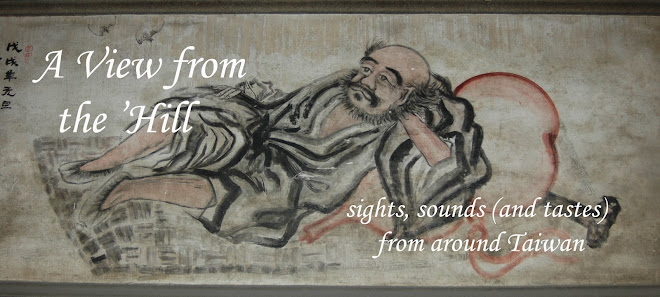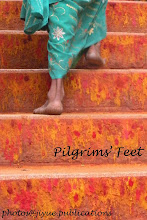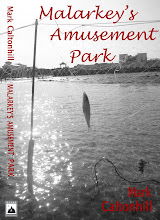Feature article published in Amcham's TOPICS magazine
A Day in the Life of a Chef/Restaurateur
BY Mark Caltonhill
Thirty-two-year-old François Parveau is a chef from Pompadour in the Limousin region of central France. He first came to Taiwan four years ago to visit his girlfriend, whom he met when both studied at the Institute Paul Bocuse in Lyon. He stayed on, they married, and Parveau became a freelance chef catering for French consular events, business dinners, and other clients. He opened the LAB restaurant in Taipei’s Minsheng Community in March 2008. Taiwan Business Topics contributor Mark Caltonhill spent a day with him in early December.
9:30 a.m.
 Turnips are the first thing on François Parveau’s shopping list. He’s running a little late – a group of customers spun out their last glasses of wine the night before – but he’s not in a hurry. He wanders around half a dozen stalls at the Binjiang vegetable market checking the turnips for size, shape, texture, and above all freshness, before returning to the second stall, where he selects just two. He repeats this process for cabbage, carrots, potatoes, asparagus spears, apples, lemons, tomatoes, and so on.
Turnips are the first thing on François Parveau’s shopping list. He’s running a little late – a group of customers spun out their last glasses of wine the night before – but he’s not in a hurry. He wanders around half a dozen stalls at the Binjiang vegetable market checking the turnips for size, shape, texture, and above all freshness, before returning to the second stall, where he selects just two. He repeats this process for cabbage, carrots, potatoes, asparagus spears, apples, lemons, tomatoes, and so on.

“No, Madame, I don’t want the imported potatoes,” Parveau says in accented but fluent Chinese. He uses local produce wherever possible, because of taste, freshness, and those deplorable carbon-footprint miles. But mostly because of quality. “If the potato cells are too big, they’re full of water and have little taste,” he explains in English.
“Quality first, second, and third,” he continues. “Still, you have to care about the cost, otherwise they’ll charge you crazy prices.” Parveau occasionally rejects a purchase because of price, but on the whole he reckons to get charged the same as locals. Most stallholders greet him, many by name. He’s obviously a feature here. He should be: he’s been coming here six mornings each week and has barely had a holiday since he opened his restaurant. (He had planned to take August off, like many restaurateurs in France, but fiscal realities made him reconsider. He will take three or four days at Lunar New Year instead.)
Parveau also greets fellow restaurateurs similarly shopping for their daily or weekly supplies. Although he says they treat him suspiciously as competition, he is happy to share information and help them with queries about French cuisine.
 With all the vegetables and fruit on his list purchased, and nothing unusual catching his eye for an impromptu canapé, Parveau steps across a back street to pick up half a dozen sea bass he’d ordered by telephone from his car on the way over. Most of his fish and meat products come through suppliers, however. He says the standards at the market can be unstable, and claims of “high mountain” or “organic” less reliable.
With all the vegetables and fruit on his list purchased, and nothing unusual catching his eye for an impromptu canapé, Parveau steps across a back street to pick up half a dozen sea bass he’d ordered by telephone from his car on the way over. Most of his fish and meat products come through suppliers, however. He says the standards at the market can be unstable, and claims of “high mountain” or “organic” less reliable.
10:30 a.m.
Back at his restaurant, Parveau puts his purchases into storage and then heads off across the Minquan Bridge to the flower market in Neihu. “Flowers are my one luxury,” Parveau confides. “Or I could say they are the most important thing. A form of respect to my customers.” He spends around NT$600 every two or three days on flowers, and around two and a half hours to buy and arrange them.
 In fact, though he originally took responsibility for the flowers, their selection and arrangement are now undertaken – under his watchful eye – by his assistant and sole employee, Tiffany Cho. “She is an artist, and wanted to learn about flowers. Now she has surpassed my expectations,” Parveau says later, displaying her creations.
In fact, though he originally took responsibility for the flowers, their selection and arrangement are now undertaken – under his watchful eye – by his assistant and sole employee, Tiffany Cho. “She is an artist, and wanted to learn about flowers. Now she has surpassed my expectations,” Parveau says later, displaying her creations.
On the drive back, he says Minsheng was the only area of Taipei that he considered when looking for a restaurant location. “With its tree-lined streets, gardens, and low-rise buildings, you can see some daylight, making it possible to live here. A restaurant must be located in an area whose standard matches the standard of the food. It is not a noisy district, and as you walk down the street you can hear people playing music, practicing the piano, and such. I like that.”
11:30 a.m.
 Parveau and Cho carry the flowers into the back part of the kitchen. Cho then starts cutting and arranging them; Parveau makes a cup of coffee and starts telephoning suppliers and customers. He taps his calculator buttons as he places orders in Chinese and discusses menus and wine choices in Chinese or English. Margins are tight, he explains.
Parveau and Cho carry the flowers into the back part of the kitchen. Cho then starts cutting and arranging them; Parveau makes a cup of coffee and starts telephoning suppliers and customers. He taps his calculator buttons as he places orders in Chinese and discusses menus and wine choices in Chinese or English. Margins are tight, he explains.
Recently Parveau redesigned the concept for LAB. Originally he only catered for private groups, drawing up menus to meet their specific needs and charging anywhere from NT$3,500 on up per head, averaging around NT$5,500, he says. At the end of 2009, he switched to offering two cheaper set menus – in consideration of the economic downturn, particularly the crisis in the financial sector in which many of his clients worked, and more importantly the opening of the highly publicized L’Atelier de Joel Robuchon under the name of the Michelin 3-star French chef, which drew away a lot of business. Before its December relaunch, LAB did not even have a sign outside.
It now has a sign advertising its presence in the neighborhood and a sample menu that is browsed by passersby. Parveau is visibly pleased. One local woman even sticks her head through the window to ask if this is in fact a restaurant. It’s hard to believe LAB opened more than 18 months earlier.
12:30 p.m.
Parveau makes a run to the bank and post office. “It’s a little time-consuming going to the bank almost every day, but I cannot bank online as I don’t read Chinese. I need to stay on top of my accounts. It can be a little problematic as most suppliers don’t use receipts and invoices, and without them, I cannot claim the costs back against tax. Even those that will write me a receipt automatically charge an extra 5%.”
He discusses his relationship with the banks, which under the current circumstances is somewhat delicate, especially since the vicissitudes of his first two years in business have seen him fall behind his initial business plan.
Tiffany Cho starts to make lunch for herself and Parveau.
1:00 p.m.
 Parveau returns, puts on plastic gloves and fillets the sea bass, carefully picking out the occasional bone missed by the vendor who has already removed the scales and innards. He cuts the fillets into 18 regularly shaped pieces for the 18 servings he will have available for customers of his more expensive “Connoisseur” menu. The scraps he gives to Cho to include in their lunch.
Parveau returns, puts on plastic gloves and fillets the sea bass, carefully picking out the occasional bone missed by the vendor who has already removed the scales and innards. He cuts the fillets into 18 regularly shaped pieces for the 18 servings he will have available for customers of his more expensive “Connoisseur” menu. The scraps he gives to Cho to include in their lunch.
1:30 p.m.
Cho sits down to eat. Parveau should too, but he is constantly interrupted by deliveries and phone calls. Morel mushrooms from one supplier, edible flowers from Holland from another, and his prized celery root from a third. “It’s not easy to find,” he says of the celery root, “but for me it’s an essential accompaniment to the frogs’ legs.”
A man from a company providing what Parveau calls “the most expensive coffee in the world” turns up to check and service the machine and deliver supplies. “It costs me around one Euro per cup, but my customers expect it.”
The coffee man is followed by a husband and wife who are booked in for Friday. They discuss some aspects of the menu with Parveau and drop off a box of bottles of wine they plan to drink with their guests. For a fine French restaurant, LAB is unusual in allowing customers to bring their own wine. Previously it was even more unusual in not charging a corkage fee either. “Some customers abused my generosity, however,” Parveau says. “Sometimes they would bring ten different bottles, and I’d spend the evening washing 150 glasses for which I’d get paid nothing.” Since the relaunch, he charges NT$400 per bottle. Ideally he’d like to sell wine himself, but his customers’ taste for bottles costing tens of thousands of NT dollars means he cannot afford to stock them.
At the time of the interview he was drawing up a more modest wine list, and said he planned to offer nine wines in the NT$2,000-$4,000 range: one Champagne; three whites (Burgundy, South Rhone, and Bordeaux) and four or five reds (Burgundy, South Rhone, Bordeaux, and something Chilean or Argentine).
The couple is followed through the door by a laundry worker delivering tablecloths and uniforms. Eventually, bite by increasingly tepid bite, Parveau finishes his lunch.
3:30 p.m.
Preparation of the evening’s fare now begins in earnest. Cho, who trained as a pastry chef in Ottawa, does the cakes, while Parveau, who spent three of his seven months at La Chevre D’or in Eze between Nice and Monaco elbow deep in the icy waters of the fish department, finishes preparing the sea bass.
Over the next three hours, both work constantly, multitasking between peeling and preparing vegetables, steaming and sautéing, whipping and pureeing…and always tasting. Windows are opened as the kitchen heats up, and timers sound out incessantly, demanding Parveau’s attention at one or another burner or oven. The two do the washing up as they go along. “Sometimes I listen to music while working, but mostly not,” says Parveau. “Hearing is an important sense in making food too.”
Most suppliers and customers seem to know not to disturb him as opening time approaches.
4:45 p.m.
Parveau personally irons each tablecloth. “I’m probably the only chef who does this in Taipei,” he jokes. “But for me it’s part of the mutual respect between chef and diner.”
He then brings out the flowers and places them on each table, beside the entrance and in the restrooms, praising Cho’s handiwork as he does so. He finishes laying the tables, checks the overall appearance of the dining room, and heads back into the kitchen, which he refers to as the “stage.” Between the two is a large glass window, allowing the diners full view of the kitchen.
“The diners see something, they see themselves, and are seen. So it’s the theater.” They even get to see Parveau and Cho do the washing up. “I wanted to do the washing up in front of the people, so they know it is not a shame to clean.”
It sounds like Parveau is on a mission. “I want to learn something every day, every day of my life. This is a huge school. That’s why I called the restaurant ‘Lab’. We’re doing research. This choice is not the easiest way, and it is not the richest way for making money, but it is the richest way for knowledge.”
So he is learning, and he hopes his customers are learning too, about French cuisine and French culture, but more broadly about appreciating the fine things in life. That’s why his two new menus are titled “Neophyte” and “Connoisseur.”
6:00 p.m.
The first diners arrive. LAB doesn’t officially open till 6:30, so they are shown into the small marquee erected in the converted first-floor apartment’s parking space. They are served Champagne and canapés: on this particular evening Comté cheese and beetroot, cucumber stuffed with mustard mayonnaise and topped with a butter-roasted shrimp, and fish mousse. The various finger foods must match each other as well as the courses to follow, as “harmony at the table is paramount,” Parveau explains.
6:30 p.m.
 The lights go on and Parveau adds the position of theater director and star actor to his earlier roles of producer, costume and set designer, and playwright, not to mention vegetable cutter, floor sweeper, tablecloth ironer, gardener, and so forth.
The lights go on and Parveau adds the position of theater director and star actor to his earlier roles of producer, costume and set designer, and playwright, not to mention vegetable cutter, floor sweeper, tablecloth ironer, gardener, and so forth.
Interestingly, Parveau says he did consider studying theater design, following one year spent in the study of pharmacy, another of drawing, three of architecture, and one more of art history, before plumping for cooking at the suggestion of a friend who had tasted the creations he served up for his fellow students.
Squid and caviar risotto with veal gravy follows the canapés when the diners are seated. The risotto rice comes from another supplier with a grip on Taiwan’s limited market. “Many restaurants make what they call risotto using local rice at one-tenth the price, but that isn’t real risotto,” Parveau maintains.
 After a suitable pause, he and Cho serve a dish of scallop poached in oolong-flavored oil with angel-hair noodles and oolong-flavored grissini. Parveau makes the grissini himself, but the bread rolls available throughout the meal come from La Fourviere. “I simply don’t have the space for a fermentation chamber and other equipment needed to provide a consistent quality of bread. Consistency is paramount in fine cuisine.”
After a suitable pause, he and Cho serve a dish of scallop poached in oolong-flavored oil with angel-hair noodles and oolong-flavored grissini. Parveau makes the grissini himself, but the bread rolls available throughout the meal come from La Fourviere. “I simply don’t have the space for a fermentation chamber and other equipment needed to provide a consistent quality of bread. Consistency is paramount in fine cuisine.”
 The customers, his audience, then watch Parveau put the finishing touches to his steamed sea bass filet under breadcrumbs with fennel-based consommé and green beans. The use of fennel is typical of southern French cuisine, he says.
The customers, his audience, then watch Parveau put the finishing touches to his steamed sea bass filet under breadcrumbs with fennel-based consommé and green beans. The use of fennel is typical of southern French cuisine, he says.
His beloved celery root next appears in a confit of frog leg in black truffle on celery root smoothie with poultry gravy, which is followed by the sixth course, free-range mountain chicken leg confit with morel and as a sausage with duck liver, accompanied by sautéed seasonal mushrooms and parsley. 
Although the meal runs to ten courses, each averaging about 80 grams, Parveau insists this is not degustation, a current trend in Taiwan and promoted by Robuchon. “I am not offering these as a ‘taste’ of the dishes on the main menu. These are designed menus, with all items in harmony, intended to help ‘neophytes’ and ‘connoisseurs’ learn about French cuisine.”
Next, the morning’s carefully selected turnips reappear as beef steak with garlic confit potato, black truffle turnip stew and port-flavored gravy. Parveau engages at length with one customer about the relative merits of U.S., New Zealand, and Australian beef, which eventually focuses on the difference between grass-fed and corn-fed meat. They agree to differ.
It is time for dessert. The sweetness of chocolate fondant with Chantilly cream and mini crème brûlée is followed by a slight sourness of raspberry mousse on pistachio biscuit with sautéed kiwi fruit with sliced almonds. “I believe in ending the meal with a sour fruit,” Parveau says. “It leaves diners feeling satisfied.” Nevertheless, there is one last mouthful of a sweet served with coffee or flower tea.
10:00 p.m.
The last diner leaves, and Parveau enjoys a post-performance cigarette on the back doorstep.
11:00 p.m.
Although they did most of the washing as they went along, tidying up, sweeping, and storing leftovers takes the best part of an hour. Both Parveau and Cho are clearly exhausted by their 14-hour workday.
So is it worth it? “I’m sure I’m doing something good,” Parveau says, “something very different. And I’m still learning, still experimenting.”







No comments:
Post a Comment